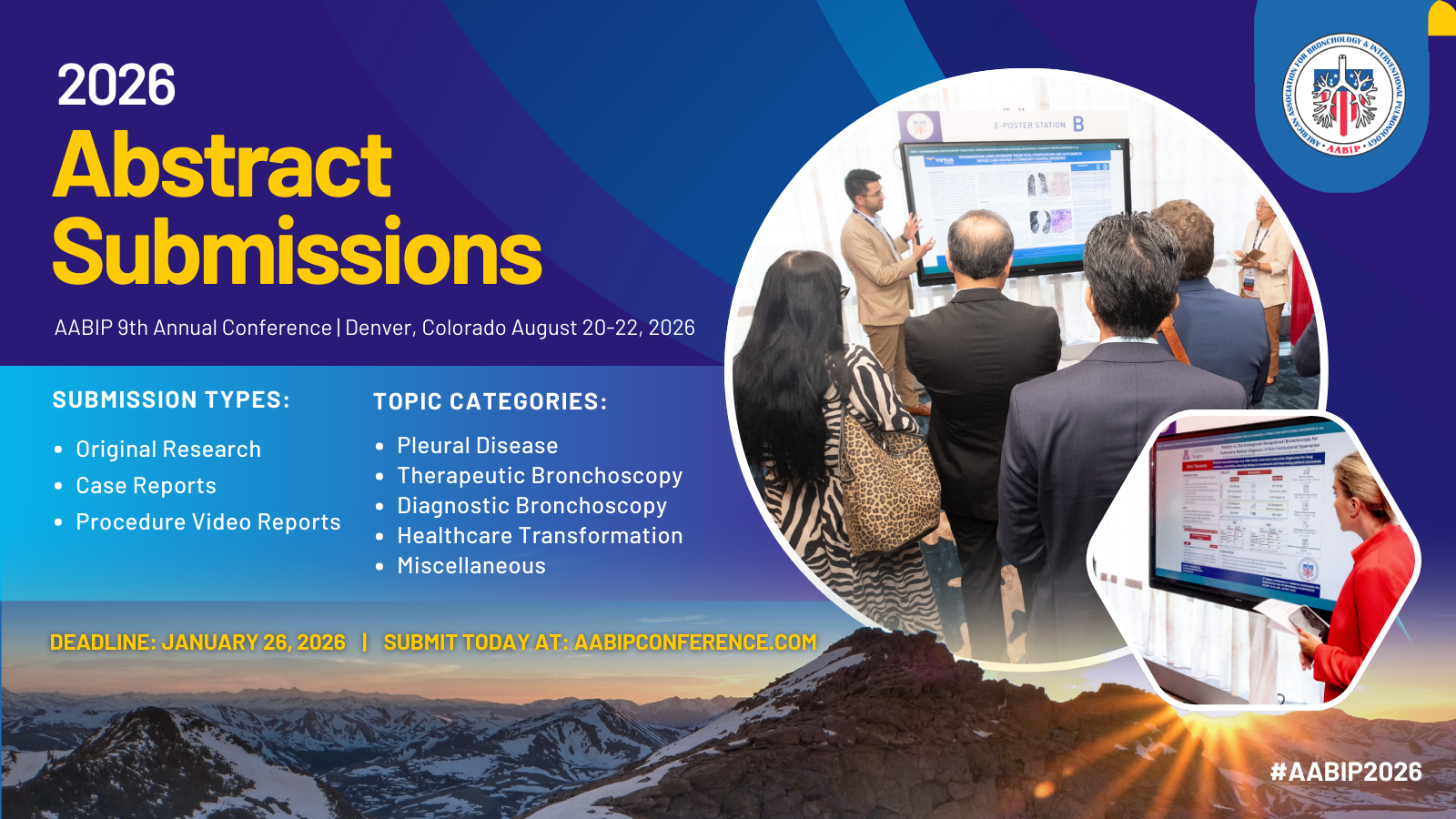AABIP IP Fellows Reading List
https://www.ncbi.nlm.nih.gov/pubmed/21963329
Landmark Article
Reference: Yasufuku K, Pierre A, Darling G, et al. A prospective controlled trial of endobronchial ultrasound-guided transbronchial needle aspiration compared with mediastinoscopy for mediastinal lymph node staging of lung cancer. J Thorac Cardiovasc Surg. 2011;142(6):1393-400.e1.
Background: A prospective study evaluating endobronchial ultrasound (EBUS)-TBNA versus mediastinoscopy for lymph node (LN) staging in lung cancer.
PICO:
Populations:
- Patients with possible non-small cell lung cancer (NSCLC) requiring staging and lung resection
Intervention:
- EBUS TBNA was followed by mediastinoscopy in these patients
Comparison:
- EBUS TBNA and mediastinoscopy
Outcome:
- There was excellent concurrence between EBUS TBNA and mediastinoscopy for mediastinal staging of patients. Specificity and positive predictive value for both techniques were also 100%. The sensitivity, negative predictive value, and diagnostic accuracy for mediastinal lymph node staging for EBUS TBNA and mediastinoscopy were very comparable.
Take Home: EBUS TBNA for NSCLC has an excellent diagnosis concurrence with mediastinoscopy and comparable yield profiles. Thus, EBUS TBNA should be used as a first procedure for staging or diagnosis of NSCLC.
Randomized clinical trial of endobronchial ultrasound needle biopsy with and without aspiration
https://www.ncbi.nlm.nih.gov/pubmed/22156610
Landmark Article
Reference: Casal RF, Staerkel GA, Ost D, et al. Randomized clinical trial of endobronchial ultrasound needle biopsy with and without aspiration. Chest. 2012;142(3):568-573.
Background: Prospective experimental RCT to assess sample quality and quantity of EBUS TBNA with suction and without suction.
PICO:
Populations:
- Patients requiring EBUS TBNA for LN sampling
Intervention:
- EBUS TBNA performed both with suction and without suction in each lymph node with randomization to avoid first pass effect.
Comparison:
Outcome:
- There was no difference in sample adequacy, sample quality, diagnostic yield for malignancy or any other condition
Take Home: There is no difference in sample adequacy and quality with EBUS TBNA with or without using capillary suction. This study did not analyze the quality and number of cells in the rinses obtained with each technique, which is important for flow cytometry and molecular analysis.
Rapid on-site cytologic evaluation during endobronchial ultrasound-guided transbronchial needle aspiration for diagnosing lung cancer: a randomized study
https://www.ncbi.nlm.nih.gov/pubmed/23571718
Clinical Trial
Reference: Oki M, Saka H, Kitagawa C, et al. Rapid on-site cytologic evaluation during endobronchial ultrasound-guided transbronchial needle aspiration for diagnosing lung cancer: a randomized study. Respiration. 2013;85(6):486-92.
Background: Prospective experimental RCT to see effect of rapid onsite cytologic evaluation (ROSE) on EBUS TBNA procedure yields, time requirements for procedures.
PICO:
Populations:
- Patients requiring EBUS TBNA for lymph node sampling
Intervention:
- EBUS TBNA of LN performed randomized with and without ROSE
Comparison:
Outcome:
- No significant difference in accuracy, sensitivity or procedure time in either group.
- Number of aspirations per LN was marginally less (2 vs 3) in the EBUS+ROSE group, though this effect is questionable compared to other similar RCT which do not show this result.
- The feedback of ROSE did reduce the number of additional procedures, compared to the non-ROSE EBUS TBNA cases, especially in first diagnostic procedures.
Take Home: The addition of ROSE to EBUS TBNA procedures could reduce additional procedures required for a diagnosis, however it does not improve yields, reduce the number of passes or procedure completion time significantly.
Rapid on-site cytologic evaluation during endobronchial ultrasound-guided transbronchial needle aspiration for nodal staging in patients with lung cancer
https://www.ncbi.nlm.nih.gov/pubmed/23245441
Clinical Trial
Reference: Nakajima T, Yasufuku K, Saegusa F, et al. Rapid on-site cytologic evaluation during endobronchial ultrasound-guided transbronchial needle aspiration for nodal staging in patients with lung cancer. Ann Thorac Surg. 2013;95(5):1695-9.
Background: Retrospective observational study showing concordance rates of ROSE for EBUS-TBNA with the final pathological diagnosis in lung cancer.
PICO:
Populations:
- Patients requiring EBUS TBNA for mediastinal lymphadenopathy staging or diagnosis in lung cancer
Intervention:
- Retrospective analysis looking at concordance of EBUS TBNA final diagnosis with ROSE preliminary diagnosis
Comparison:
Outcome:
- Concordance rate between ROSE and final EBUS TBNA in staging lung cancer 94%, with no false positive by ROSE; and 5.7% false negative by ROSE diagnosis.
Take Home: There is good concordance with ROSE diagnosis for specimens obtained by EBUS TBNA on the final pathological diagnosis, with a low false negative rate.
Endobronchial ultrasound-guided transbronchial needle aspiration vs conventional transbronchial needle aspiration in the diagnosis of sarcoidosis
https://www.ncbi.nlm.nih.gov/pubmed/24481031
Clinical Trial
Reference: Gupta D, Dadhwal DS, Agarwal R, Gupta N, Bal A, Aggarwal AN. Endobronchial ultrasound-guided transbronchial needle aspiration vs conventional transbronchial needle aspiration in the diagnosis of sarcoidosis. Chest. 2014;146(3):547-556.
Background: Prospective RCT defining role of EBUS TBNA compared to conventional TBNA for diagnosis of sarcoidosis.
PICO:
Populations:
- Patients with clinically suspected sarcoidosis
Intervention:
- Patients were randomized to either EBUS TBNA or conventional TBNA (cTBNA) arm for LN fine needle aspiration (FNA); with both arms receiving transbronchial (TBLB) and endobronchial biopsies (EBB) additionally.
Comparison:
- EBUS TBNA versus conventional TBNA of LN for sarcoidosis
Outcome:
- EBUS TBNA has very high diagnostic yield compared to cTBNA for sarcoidosis.
- Addition of EBB/TBLB to cTBNA increased granuloma detection significantly. Addition of TBLB only to EBUS TBNA also increased granuloma detection significantly.
- Procedure time was more with EBUS TBNA compared to cTBNA.
Take Home: EBUS TBNA has the highest diagnostic yield in sarcoidosis, but it should be combined with TBLB for an optimal yield. The diagnostic yield of cTBNA (plus EBB and TBLB) is similar to EBUS TBNA plus TBLB.
EBUS-TBNA and EUS-FNA: Risk Assessment for Patients Receiving Clopidogrel
https://www.ncbi.nlm.nih.gov/pubmed/27479011
Clinical Trial
Reference: Meena N, Abouzgheib W, Patolia S, Rosenheck J, Boujaoude Z, Bartter T. EBUS-TBNA and EUS-FNA: Risk Assessment for Patients Receiving Clopidogrel. J Bronchology Interv Pulmonol. 2016;23(4):303-307.
Background: Retrospective study evaluating safety and risk assessment analysis for EBUS TBNA and Esophageal Ultrasound (EUS) in patients taking clopidogrel
PICO:
Populations:
- Patients undergoing EBUS TBNA on clopidogrel, N=37
Intervention:
Comparison:
- Risk/complication profile review in control cases for EBUS TBNA off antiplatelet agents
Outcome:
- No major bleeding, drop in hematocrit or other complications noted in the clopidogrel EBUS TBNA group when performed by an experienced operator.
Take Home: EBUS TBNA/EUS FNA can be performed with a reasonable safety profile in patients on clopidogrel when an important diagnostic question needs to be answered.
Evaluation of a novel endobronchial ultrasound-guided lymph node forceps in enlarged mediastinal lymph nodes
https://www.ncbi.nlm.nih.gov/pubmed/23860465
Clinical Trial
Reference: Darwiche K, Freitag L, Nair A, et al. Evaluation of a novel endobronchial ultrasound-guided lymph node forceps in enlarged mediastinal lymph nodes. Respiration. 2013;86(3):229-36.
Background: Prospective single center study assessing feasibility and yield assessments of EBUS transbronchial forceps biopsy (EBUS TBFB) in patients referred for EBUS TBNA.
PICO:
Populations:
- Patients referred for EBUS TBNA
Intervention:
- EBUS TBFB in patients undergoing EBUS TBNA using a newly developed LN forceps (MTW™ Endoskopie, Germany)
Comparison:
- Assessments of diagnostic yield improvements with addition of EBUS TBFB to EBUS TBNA
Outcome:
- EBUS TBFB increased the diagnostic yield of EBUS TBNA from 64 to 93% in benign conditions. The overall diagnostic yield was higher compared to EBUS TBNA alone.
- EGFR mutation analysis could be achieved in the forceps biopsy samples as needed. No complications were observed with EBUS TBFB.
Take Home: EBUS TBFB with a novel lymph node forceps are safe, increases the diagnostic yield in benign conditions and may add value in molecular analysis of NSCLC.
Endobronchial Ultrasound-Guided Transbronchial Needle Aspiration for the Diagnosis and Subtyping of Lymphoma
https://www.ncbi.nlm.nih.gov/pubmed/26146788
Clinical Trial
Reference: Grosu HB, Iliesiu M, Caraway NP, et al. Endobronchial Ultrasound-Guided Transbronchial Needle Aspiration for the Diagnosis and Subtyping of Lymphoma. Ann Am Thorac Soc. 2015;12(9):1336-44.
Background: Retrospective study trying to see feasibility for diagnosis of type of lymphoma from EBUS TBNA samples instead of excisional biopsies.
PICO:
Populations:
- Patients with suspected lymphoma needing a tissue diagnosis
Intervention:
- EBUS TBNA performed and specimen handled as per single institution protocol/algorithm
Comparison:
Outcome:
- 181 patients included, 75 (41.5%) were ultimately diagnosed with lymphoma. EBUS TBNA was able to establish a diagnosis of lymphoma in 63 patients (84%). Granulomatous inflammation and adequate lymphocytes diagnosed on the basis of EBUS TBNA were associated with a low likelihood of lymphoma being present. EBUS TBNA was able to establish a diagnosis and subtype the lymphoma in 67% of patients with de novo lymphoma and 81% of patients with relapsed lymphoma.
Take Home: EBUS TBNA is a minimally invasive and good diagnostic test for lymphoma. It is important to have a specimen processing protocol if lymphoma is in consideration.
Endosonography for mediastinal disease: esophageal ultrasound vs. endobronchial ultrasound
https://www.ncbi.nlm.nih.gov/pubmed/26357674
Clinical Trial
Reference: Meena N, Bartter T. Endosonography for mediastinal disease: esophageal ultrasound vs. endobronchial ultrasound. Endosc Int Open. 2015;3(4):E302-6.
Background: This study evaluated and compared the procedural characteristics of EBUS and EUS in patients requiring mediastinal lymph node staging.
PICO:
Populations:
- Patients requiring mediastinal lymph node staging by EBUS or EUS
Intervention:
- EBUS or EUS or both and comparison of their procedural characteristics
Comparison:
- Retrospective review EBUS vs. EUS for mediastinal staging of lung cancer
Outcome:
- 155 procedures were analyzed (61 EUS, 73 EBUS, 21 EUS + EBUS).
- EUS required approximately one-half of the time required for EBUS or the combined procedures.
- Sedation dosing was statistically lower for EUS and not significantly different between EBUS and the combined approach.
- EUS also involved lower oxygen requirements and shorter time to discharge.
Take Home: In this study, EUS involved statistically significant economies of time and sedation when compared to EBUS. This study was published in an endoscopic journal. In specific clinical scenarios, EUS can be considered for mediastinal sampling.
Technical Aspects of Endobronchial Ultrasound-Guided Transbronchial Needle Aspiration: CHEST Guideline and Expert Panel Report
https://www.ncbi.nlm.nih.gov/pubmed/26402427
Guideline
Reference: Wahidi MM, Herth F, Yasufuku K, et al. Technical Aspects of Endobronchial Ultrasound-Guided Transbronchial Needle Aspiration: CHEST Guideline and Expert Panel Report. Chest. 2016;149(3):816-35.
Summary: CHEST (ACCP) Systematic review and guidelines for performing EBUS TBNA.
Combined endobronchial and esophageal endosonography for the diagnosis and staging of lung cancer: European Society of Gastrointestinal Endoscopy (ESGE) Guideline, in cooperation with the European Respiratory Society (ERS) and the European Society of Thoracic Surgeons (ESTS)
https://www.ncbi.nlm.nih.gov/pubmed/26030890
Guideline
Reference: Vilmann P, Clementsen PF, Colella S, et al. Combined endobronchial and esophageal endosonography for the diagnosis and staging of lung cancer: European Society of Gastrointestinal Endoscopy (ESGE) Guideline, in cooperation with the European Respiratory Society (ERS) and the European Society of Thoracic Surgeons (ESTS). Endoscopy. 2015;47(6):545-59.
Summary: ESGE/ERS/ESTS guidelines for EBUS/EUS in lung cancer staging.
A prospective, randomized trial for the comparison of 19-g and 22-g endobronchial ultrasound-guided transbronchial aspiration needles; introducing a novel end point of sample weight corrected for blood content
https://pubmed.ncbi.nlm.nih.gov/30914312/
Clinical Trial
Reference: Wolters C, Darwiche K, Franzen D, et al. A prospective, randomized trial for the comparison of 19-g and 22-g endobronchial ultrasound-guided transbronchial aspiration needles; introducing a novel end point of sample weight corrected for blood content. Clin Lung Cancer. 2019;20(3):e265-e273.
Background: Both the 21-G and 22-G EBUS needles are commonly used to sample intrathoracic lymph nodes. This is a prospective, randomized 2-center trial comparing the tissue quality, diagnostic yield, feasibility, safety, performance, and blood content between 19-G and 22-G EBUS needles.
PICO:
- Population
- Patients suspected of having lung cancer with mediastinal and/or hilar adenopathy requiring EBUS-TBNA for diagnosis.
- Intervention
- Selected patients were randomized to undergo EBUS-TBNA with either a 22-G or 19-G needle.
- Comparison
- The tissue quality, diagnostic yield, feasibility, safety, performance, and blood content were compared between the 22-G and 19-G needles.
- Outcome
- A total of 107 patients were enrolled with 54 (50.5%) in the 22-G group and 53 (49.5%) in the 19-G group.
- The 19-G needle was associated with significantly higher blood content (p = 0.29) and after controlling for blood content, the sample weight was significantly higher with the 19=G needle compared with the 22-G needle (p = 0.0119).
- The number of tumor cells was significantly higher in the 19-G needle compared to the 22-G needle (p = 0.0312).
- The diagnostic yield was comparable between the 19-G and 22-G needles.
- Complications were comparable with two moderate bleeding events occurring in each group.
Take home: Although the 19-G EBUS needle can provide significantly more tissue without an increased risk of complications, the diagnostic yield is similar compared to the 22-G needle.
Adequacy of small biopsy and cytology specimens for comprehensive genomic profiling of patients with non-small-cell lung cancer to determine eligibility for immune checkpoint inhibitor and targeted therapy
https://pubmed.ncbi.nlm.nih.gov/33952592/
Clinical Trial
Reference: Faber E, Grosu H, Sabir S, et al. Adequacy of small biopsy and cytology specimens for comprehensive genomic profiling of patients with non-small-cell lung cancer to determine eligibility for immune checkpoint inhibitor and targeted therapy. J Clin Pathol. Published online May 5, 2021:jclinpath-2021-207597.
Background: The adequacy of small specimens from needle biopsies for guideline recommended genomic biomarker testing in non-small cell lung cancer (NSCLC) has been unclear. This is a single center, retrospective study evaluating the adequacy of image-guided core needle biopsy (CNB) and fine-needle aspiration (FNA) specimens for genomic biomarker testing.
PICO:
- Population
- Patients that underwent image-guided CNB or FNA for lung cancer biomarker testing.
- Intervention
- Patients underwent image-guided CNB and/or transthoracic FNA (TTNA) or endobronchial ultrasound guided transbronchial needle aspiration (EBUS-TBNA).
- Comparison
- The adequacy of tissue for lung cancer genomic biomarker testing obtained by CNB, TTNA, and EBUS-TBNA was compared.
- Outcome
- A total of 865 cases were evaluated with 785 cases undergoing testing for all lung cancer biomarkers which were obtained by 679 CNB, 150 EBUS-TBNA, and 36 TTNA cases.
- EBUS-TBNA was performed with a 22-G needle 92% of the time; with a few cases using a 21-G (3%) or 20-G (4%). The median number of needle passes was 6 (range 2-12) with a median lesion size of 1.7 cm (range 0.5 – 5.4 cm).
- Overall, the adequacy of tissue for complete lung biomarker testing was obtained in 87% of cases (679/785). EBUS-TBNA obtained adequate tissue for complete lung biomarker testing in 77% of cases and partial testing in 12% compared to CNB with 90% and 7% and TTNA with 72% and 11%, respectively.
- No patients who underwent EBUS-TBNA had an adverse event compared to 15% in the CNB group and 11% in the TTNA group.
Take home: Guideline recommended lung biomarker testing is important in NSCLC. Small specimens obtained from EBUS-TBNA, and other image-guided needle biopsies are adequate to perform complete guideline recommended lung biomarker testing in the majority of cases.
Complications, consequences, and practice patterns of endobronchial ultrasound-guided transbronchial needle aspiration: Results of the AQuIRE registry
https://pubmed.ncbi.nlm.nih.gov/23117878/
Prospective
Reference: Eapen GA, Shah AM, Lei X, et al. Complications, consequences, and practice patterns of endobronchial ultrasound-guided transbronchial needle aspiration: Results of the AQuIRE registry. Chest. 2013;143(4):1044-1053.
Background: Prior to this, few studies had been large enough to identify risk factors for complications associated with EBUS-TBNA. The goal of this study was to quantity the incidence of and risk factors for complications in patients undergoing EBUS-TBNA.
PICO:
- Population
- 1,317 patients, 6 hospitals
- Intervention
- Comparison
- Outcome
- Complications occurred in 19 patients
- TBBx was the only risk factor for complications
- TBBx was performed in 12.6% of patients when ROSE was used, and 19.1% when it was not
- There was significant interhospital variability in TBBx use when ROSE was used
Take home: ROSE significantly reduced the use of TBBx. TBBX was the only risk factor for complication during EBUS-TBNA procedures.
|








